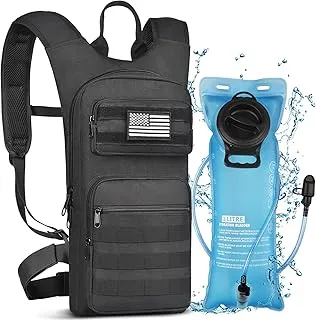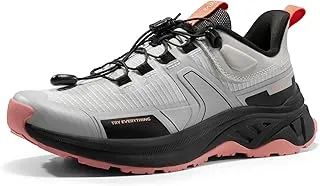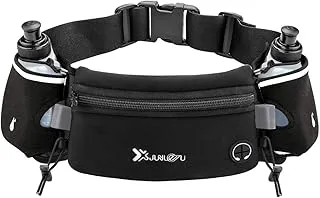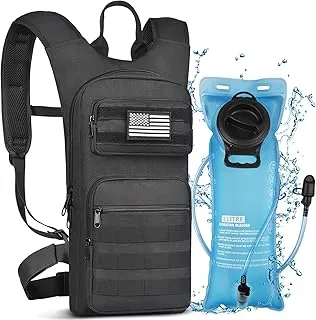
Complete Summer Hiking Packing List: Essential Gear for Hot Weather Adventures
After years of hiking through scorching desert trails and humid mountain paths, I've learned that having the right summer hiking packing list can make the difference between an epic adventure and a miserable experience. From essential hydration systems to sun protection gear, this comprehensive guide covers everything you need for safe and enjoyable hot weather hiking. Whether you're planning a day hike or multi-day trek, these tested recommendations from Nature Guests will keep you cool, hydrated, and protected on the trails.
Essential Backpack and Hydration Systems
When I first started summer hiking in Arizona's Sonoran Desert, I learned the hard way that choosing the right backpack and hydration system isn't just about comfort—it's about survival. Your summer hiking packing list should start with a lightweight, well-ventilated daypack that won't trap heat against your back. I've tested dozens of packs over the years, and ventilated designs with mesh panels make an enormous difference in temperature regulation.
For day hikes in hot weather, I recommend a 20-25L capacity pack that's specifically designed for breathability. The suspended mesh back panels create airflow between your back and the pack, reducing sweat buildup by up to 30% compared to traditional designs. After hiking the Grand Canyon's Bright Angel Trail multiple times in summer, I can attest that this feature alone prevents heat exhaustion on challenging climbs.

Ultra-lightweight hiking backpack with ventilation system
Hydration System Recommendations
Hydration systems are critical for any summer hiking packing list. I prefer hydration bladders over water bottles for hot weather hiking because they encourage more frequent drinking and keep water cooler for longer periods. A 3-liter bladder is ideal for full-day summer hikes, providing enough water while maintaining reasonable pack weight.
Professional guides I've worked with in places like Utah's Zion National Park consistently recommend investing in quality hydration systems. The insulated tube sleeves prevent water from heating up in the tube, and bite valves with dust covers keep your water clean during dusty trail conditions. For comprehensive gear advice, check out our detailed camping vs hiking gear comparison to understand the differences in equipment needs.
Pro Tip: Fill your hydration bladder with ice-cold water and freeze it overnight before early morning starts. The ice will melt gradually, providing refreshingly cool water throughout your hike.
Summer Hiking Footwear and Clothing

Breathable hiking shoes with quick-dry technology
Footwear selection for your summer hiking packing list requires balancing protection, breathability, and comfort. After hiking through Death Valley in July (admittedly not my brightest idea), I learned that lightweight, breathable hiking shoes outperform heavy boots in hot conditions. Trail running shoes or lightweight hikers with mesh panels provide adequate protection while allowing crucial airflow.
I've found that shoes with synthetic materials dry faster than leather options, which is essential when crossing streams or dealing with sudden afternoon thunderstorms common in summer mountain hiking. The key is finding shoes that balance ankle support with breathability—you want protection without creating a sweat trap around your feet.
Clothing strategy for hot weather hiking centers on moisture-wicking, sun protection, and layering flexibility. I always pack lightweight merino wool or synthetic blend shirts that wick moisture while providing natural odor resistance. Long-sleeve shirts might seem counterintuitive for summer, but they provide essential sun protection while actually keeping you cooler than exposed skin in direct sunlight.
The layering system I've developed through years of summer hiking includes a moisture-wicking base layer, an insulating mid-layer for early morning starts or high-altitude temperature drops, and a lightweight wind/rain shell. Even in summer, mountain weather can change rapidly, and being prepared prevents dangerous exposure situations. For specialized weather gear recommendations, our hiking gear for rainy weather guide provides essential insights for unpredictable conditions.
Summer Clothing Essentials
- UPF-rated long-sleeve shirt (lightweight, breathable fabric)
- Moisture-wicking hiking shorts with built-in liner
- Wide-brimmed hat with chin strap for wind resistance
- Merino wool or synthetic hiking socks (avoid cotton)
- Lightweight rain jacket for afternoon storms
Heat management through clothing choice has saved me from heat exhaustion on multiple occasions. Light-colored clothing reflects heat better than dark colors, and loose-fitting garments allow for better air circulation. I learned this lesson hiking the Narrows in Zion, where proper clothing made the difference between comfort and dangerous overheating in the desert canyon environment.
Expert Summer Hiking Gear Recommendations
Professional insights on summer hiking gear selection and packing strategies
Food, Water, and Nutrition Planning
Nutrition planning for your summer hiking packing list requires understanding how heat affects your body's needs and food preservation. After experiencing severe cramping during a summer ascent of Mount Whitney due to inadequate electrolyte replacement, I've learned that hot weather hiking demands more than just increased water consumption—it requires strategic nutrition management.
Water requirements increase dramatically in hot weather, but over-hydration without electrolyte replacement can be equally dangerous. I follow the guideline of one liter per two hours of hiking in temperatures above 80°F, plus an additional liter for every 1,000 feet of elevation gain. However, I supplement this with electrolyte tablets or natural options like coconut water to maintain proper sodium balance.

Hydration belt system for easy access to water and electrolytes
Food selection for summer hiking focuses on items that won't spoil in heat, provide sustained energy, and are easy to digest when your appetite may be suppressed by high temperatures. I avoid dairy products and opt for nuts, dried fruits, energy bars, and jerky that can withstand temperature fluctuations. Fresh fruits like apples and oranges provide both nutrition and additional hydration while remaining stable in warm conditions.
Summer Hiking Nutrition Strategy
Pre-Hike Fueling
- Complex carbohydrates 2-3 hours before
- Hydrate with 16-20 oz water upon waking
- Avoid heavy, fatty foods that slow digestion
On-Trail Nutrition
- Consume 200-300 calories per hour
- Mix of simple and complex carbohydrates
- Electrolyte replacement every 2 hours
Temperature management of food and water becomes critical in summer conditions. I use insulated water bottles or hydration bladders with insulation sleeves to keep water cool longer. A simple trick I learned from desert guides is to wet a bandana and wrap it around your water bottle—evaporation creates cooling that can keep water 10-15 degrees cooler than ambient temperature.
Meal timing adjustments for hot weather hiking can significantly improve comfort and performance. I prefer larger meals during cooler morning and evening hours, with smaller, frequent snacks during peak heat periods when appetite naturally decreases. This approach maintains energy levels while reducing digestive stress when your body is already working hard to regulate temperature. For detailed nutrition planning strategies, explore our comprehensive REI gear recommendations for expert-tested equipment options.
Sun Protection and Weather Preparedness
Sun protection is perhaps the most critical component of any summer hiking packing list, yet it's often underestimated until you experience the consequences. I learned this lesson during a rim-to-rim hike in Grand Canyon National Park, where inadequate sun protection led to severe sunburn that affected my hiking ability for days afterward. At elevation and in reflective environments like snow fields or canyon walls, UV radiation intensity increases significantly beyond typical ground-level exposure.

Complete hydration system with weather protection
Comprehensive sun protection extends beyond sunscreen to include physical barriers, timing strategies, and understanding UV index variations. I always pack a wide-brimmed hat with UPF protection, polarized sunglasses with full UV protection, and lightweight sun gloves for exposed hand protection during long exposure periods. These items work together to create multiple layers of protection against harmful radiation.
Sunscreen application and reapplication become critical in summer hiking conditions where sweating reduces effectiveness. I use broad-spectrum SPF 30+ sunscreen applied 30 minutes before sun exposure, with reapplication every two hours or after excessive sweating. Stick formulations work better than lotions for face application during active hiking, as they resist running into eyes with perspiration.
Weather preparedness for summer hiking must account for rapid weather changes common in mountainous regions and the unique challenges of summer storms. Afternoon thunderstorms develop quickly in many hiking areas, bringing lightning danger, flash flood risks, and sudden temperature drops. I always check detailed weather forecasts and radar patterns before departure, but pack preparation for unexpected weather changes regardless of predictions.
Weather Protection Essentials
Lightning Safety
Avoid ridges and peaks during storms; seek low ground away from isolated trees
Flash Flood Awareness
Never camp in washes; storms miles away can create deadly water flows
Temperature Drops
Pack insulating layer even for summer hikes; storms can drop temperatures 20-30°F
Heat management strategies become essential when traditional shade isn't available on exposed ridges or desert terrain. I carry a lightweight emergency bivy or space blanket that can create artificial shade during rest stops or emergency situations. These items weigh mere ounces but can provide life-saving cooling when natural shelter isn't available.
Understanding UV exposure timing helps optimize hiking schedules for safer sun exposure. UV radiation peaks between 10 AM and 4 PM, making early morning and late afternoon the safest times for exposed hiking. When hiking during peak UV hours is unavoidable, I increase rest frequency in shaded areas and adjust pace to prevent overheating combined with sun exposure. This comprehensive approach to sun and weather protection has prevented numerous close calls during challenging summer hiking conditions throughout the Southwest.
Personal Care and First Aid Essentials
Personal care and first aid components of your summer hiking packing list require special consideration for heat-related conditions and extended sun exposure effects. I've developed my current first aid protocol after treating everything from heat exhaustion to severe dehydration on summer hiking trips, often in situations where professional medical help was hours away. The focus shifts from typical hiking injuries to prevention and treatment of heat-related illnesses.
Heat-Related Emergency Preparedness
Heat exhaustion and heat stroke are real dangers that I've witnessed on popular summer hiking trails like the South Kaibab Trail in Grand Canyon. Recognizing early symptoms and having treatment supplies immediately accessible can prevent life-threatening escalation. My first aid kit now prioritizes heat illness treatment over typical hiking injuries.
Recognition Signs
- Excessive sweating or cessation of sweating
- Nausea, dizziness, or confusion
- Rapid, weak pulse or elevated body temperature
Treatment Supplies
- Electrolyte tablets and extra water
- Instant cold packs for cooling
- Emergency space blanket for shade creation
Foot care becomes particularly important during summer hiking when increased mileage and heat create perfect conditions for blisters and hot spots. I carry blister prevention tape, anti-chafing balm, and multiple pairs of moisture-wicking socks for longer hikes. Changing socks at midday during hot weather hiking prevents moisture buildup that leads to skin breakdown and bacterial infections.
Personal hygiene maintenance during summer hiking extends beyond comfort to health and safety considerations. Bacterial growth accelerates in hot, humid conditions, making proper wound cleaning and personal cleanliness critical for preventing infections. I pack alcohol-based hand sanitizer, biodegradable soap for cleaning, and antiseptic wipes for wound care that won't contaminate water sources.
Summer-Specific First Aid Kit
Heat Treatment
- Instant cold packs
- Electrolyte tablets
- Cooling towels
- Digital thermometer
Sun Protection
- Aloe vera gel
- Burn treatment gel
- Extra sunscreen
- Lip balm with SPF
General Care
- Blister treatment pads
- Anti-chafing balm
- Antiseptic wipes
- Elastic bandages
Medication considerations for summer hiking include ensuring proper storage of temperature-sensitive medications and having emergency medications readily accessible. I store medications in insulated containers to prevent heat damage and carry emergency medications like antihistamines for increased allergen exposure and pain relievers for heat-related headaches in easily accessible pockets.
Mental health and decision-making support becomes crucial during challenging summer hiking conditions when heat stress affects cognitive function. I carry a simple decision-making checklist and emergency contact information in waterproof storage, along with pre-planned turnaround criteria that don't rely on heat-impaired judgment. This systematic approach to personal care and emergency preparedness has prevented several potentially dangerous situations during extreme summer hiking conditions across the western United States. For additional safety recommendations, check our complete summer hiking safety guide for comprehensive safety protocols.
Conclusion
Creating an effective summer hiking packing list requires understanding that hot weather hiking presents unique challenges that demand specialized preparation and equipment choices. Through years of hiking in extreme summer conditions across diverse environments—from the desert Southwest to high-altitude alpine trails—I've learned that success depends on prioritizing hydration systems, heat management, sun protection, and emergency preparedness above traditional hiking concerns.
The investment in proper summer hiking gear pays dividends in safety, comfort, and enjoyment of your outdoor adventures. Quality hydration systems, breathable clothing, appropriate footwear, and comprehensive sun protection transform potentially dangerous summer hiking into rewarding experiences that showcase nature's summer beauty. Remember that conditions can change rapidly in summer mountain environments, making preparation and backup planning essential components of any hiking strategy.
Ready to Gear Up for Summer Adventures?
Start building your perfect summer hiking setup with these professionally tested recommendations.
Most importantly, summer hiking should be approached with respect for the environment and understanding of your personal limits. Start with shorter, less challenging hikes to test your gear and acclimatize to hot weather conditions before attempting longer or more remote adventures. Each hiking experience builds knowledge and confidence that contributes to safer, more enjoyable future adventures.
The rewards of well-planned summer hiking are immense—from witnessing sunrise over desert landscapes to experiencing the cooling relief of alpine lakes during peak summer heat. By following this comprehensive summer hiking packing list and adapting recommendations to your specific hiking environment and personal needs, you'll be prepared to safely enjoy the unique beauty that summer hiking offers.
Remember to always inform someone of your hiking plans, check current weather and trail conditions, and never hesitate to turn back if conditions exceed your preparation level. Summer hiking adventures should challenge and inspire you while keeping safety as the absolute priority. With proper preparation and the right gear, summer's long days and spectacular lighting create some of the most memorable hiking experiences possible.
This comprehensive summer hiking packing list represents years of field testing and real-world experience across diverse summer hiking environments.
Disclaimer: Always check current trail conditions and weather forecasts before hiking. This guide provides general recommendations and should be adapted to your specific hiking environment and personal experience level.

